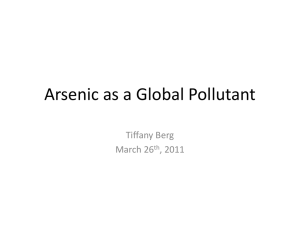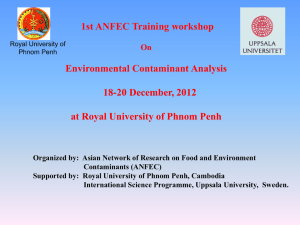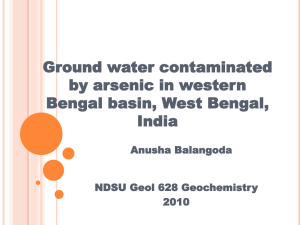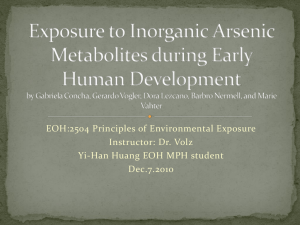A Comparative Evaluation and Field Implementation of Treatment
advertisement
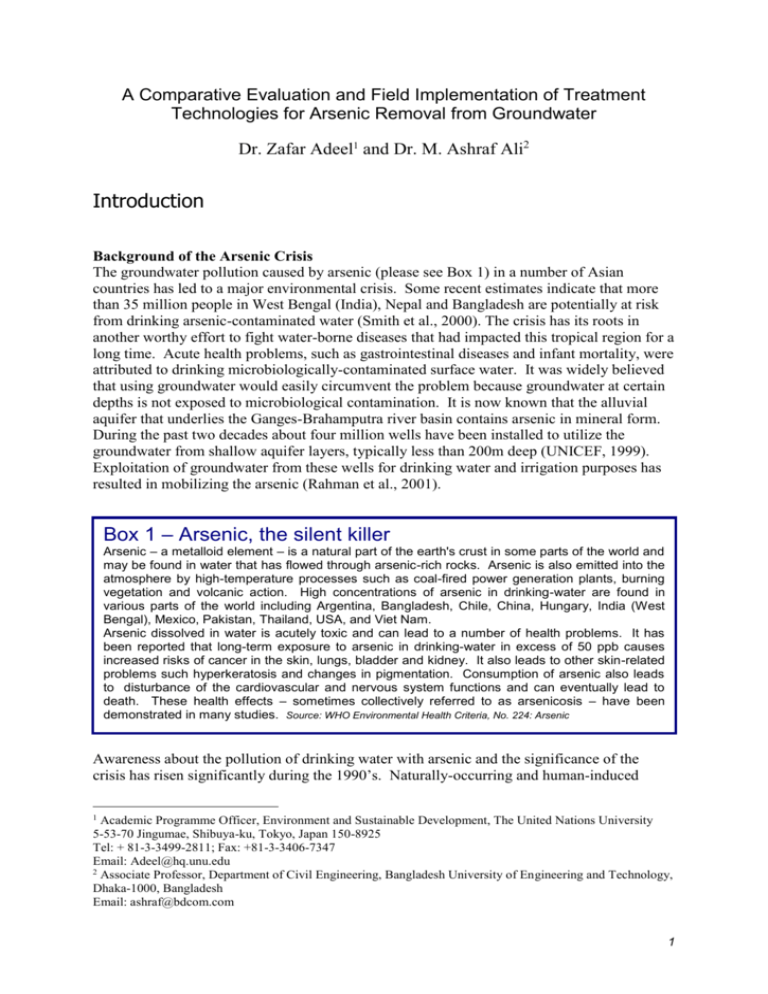
A Comparative Evaluation and Field Implementation of Treatment Technologies for Arsenic Removal from Groundwater Dr. Zafar Adeel1 and Dr. M. Ashraf Ali2 Introduction Background of the Arsenic Crisis The groundwater pollution caused by arsenic (please see Box 1) in a number of Asian countries has led to a major environmental crisis. Some recent estimates indicate that more than 35 million people in West Bengal (India), Nepal and Bangladesh are potentially at risk from drinking arsenic-contaminated water (Smith et al., 2000). The crisis has its roots in another worthy effort to fight water-borne diseases that had impacted this tropical region for a long time. Acute health problems, such as gastrointestinal diseases and infant mortality, were attributed to drinking microbiologically-contaminated surface water. It was widely believed that using groundwater would easily circumvent the problem because groundwater at certain depths is not exposed to microbiological contamination. It is now known that the alluvial aquifer that underlies the Ganges-Brahamputra river basin contains arsenic in mineral form. During the past two decades about four million wells have been installed to utilize the groundwater from shallow aquifer layers, typically less than 200m deep (UNICEF, 1999). Exploitation of groundwater from these wells for drinking water and irrigation purposes has resulted in mobilizing the arsenic (Rahman et al., 2001). Box 1 – Arsenic, the silent killer Arsenic – a metalloid element – is a natural part of the earth's crust in some parts of the world and may be found in water that has flowed through arsenic-rich rocks. Arsenic is also emitted into the atmosphere by high-temperature processes such as coal-fired power generation plants, burning vegetation and volcanic action. High concentrations of arsenic in drinking-water are found in various parts of the world including Argentina, Bangladesh, Chile, China, Hungary, India (West Bengal), Mexico, Pakistan, Thailand, USA, and Viet Nam. Arsenic dissolved in water is acutely toxic and can lead to a number of health problems. It has been reported that long-term exposure to arsenic in drinking-water in excess of 50 ppb causes increased risks of cancer in the skin, lungs, bladder and kidney. It also leads to other skin-related problems such hyperkeratosis and changes in pigmentation. Consumption of arsenic also leads to disturbance of the cardiovascular and nervous system functions and can eventually lead to death. These health effects – sometimes collectively referred to as arsenicosis – have been demonstrated in many studies. Source: WHO Environmental Health Criteria, No. 224: Arsenic Awareness about the pollution of drinking water with arsenic and the significance of the crisis has risen significantly during the 1990’s. Naturally-occurring and human-induced 1 Academic Programme Officer, Environment and Sustainable Development, The United Nations University 5-53-70 Jingumae, Shibuya-ku, Tokyo, Japan 150-8925 Tel: + 81-3-3499-2811; Fax: +81-3-3406-7347 Email: Adeel@hq.unu.edu 2 Associate Professor, Department of Civil Engineering, Bangladesh University of Engineering and Technology, Dhaka-1000, Bangladesh Email: ashraf@bdcom.com 1 arsenic pollution in drinking water has since been discovered in many parts of the world (please see Box 1). It is now recognized that dealing with arsenic contamination in groundwater may be a problem of global dimensions. Available Options for “Safe” Water Supply A “safe” water supply can be defined as one that provides water that is arsenic-safe and free from other chemical and microbiological pollutants. A number of available options can be mentioned here briefly. First, some deeper aquifers have been found to be arsenic-free and can be utilized for accessing to safe water. Concerns about cross-contamination of the deeper aquifers by arsenic seeping from shallow aquifers remain significantly important, however. Second, shallow hand-dug wells in some areas have also shown to be arsenic-free. These are, in turn, vulnerable to microbiological contamination from the surface sources. Third, rainwater harvesting can also be utilized in some areas where sufficient rainfall is available throughout the year. Rainwater harvesting can potentially suffer from microbiological contamination and may require some form of treatment to ensure its safety. Fourth, surface water may be treated at the point-of-use or at community level. Fifth, a number of arsenicremoval technologies can provide safe and clean water for human consumption. These can be implemented at both community and household levels; issues related to management of the arsenic-contaminated waste generated by these technologies has not been fully resolved yet. Sixth, piped water supply – where the source could be treated surface or groundwater – is also viewed as an ideal, but expensive, long term solution. It is important to point out that each of the safe water options has some challenges in its implementation on a larger scale. The capital costs and the costs associated with effective operation and maintenance of each option has to be carefully weighed. Water supply experts at a recent meeting3 have recommended that piped water supply should be deemed as the eventual target, but any of the other options can be utilized locally in accordance with the persisting local conditions. UNU’s Role in Research on the Arsenic Crisis The mandate of UNU envisions it to undertake policy-relevant research on issues of global concern. In the context of the arsenic crisis, UNU has undertaken research with its partners to address some of the key issues and has also been in involved in formulation of policies to cope with the arsenic crisis. The focus of UNU’s research has been on Bangladesh, yet the findings are applicable in other developing countries. In its research endeavors, UNU primarily collaborates with the Bangladesh University of Engineering and Technology (BUET). As a first phase of the research work, development of economical technologies/methods for treating arsenic contamination at household level was undertaken, considering the local conditions in Bangladesh. A number of technologies were evaluated in the laboratory and at pilot scale. The findings from this research study are presented in this paper. An international workshop was held in Dhaka in collaboration with BUET (BUET-UNU, 2001), entitled “Technologies For Arsenic Removal From Drinking Water.” This meeting 3 International Workshop on Arsenic Mitigation in Bangladesh, 14-16 January 2002, Ministry of Local Government, Rural Development and Cooperative, Government of Bangladesh, Dhaka, Bangladesh. 2 undertook the following tasks: (i) evaluated different technologies that are currently available for arsenic treatment; (ii) identified critical directions for further research on these technologies; and (iii) included some scenario development for practical application of technologies, including an economic evaluation of various alternatives. It also provided a forum for various researchers, international organizations and vendors to present the latest developments in arsenic removal technologies. In a new joint research project with BUET, UNU is now focusing on some of the key issues related to the fate of arsenic in the environment. The overall objectives of this research work are: (a) to estimate overall mass of arsenic extracted with groundwater each year; (b) to estimate the quantity of arsenic deposited in agricultural soils; and (c) to estimate the arsenic concentration in soil and selected crop/vegetable, both in some arsenic-affected and unaffected areas. This research will also include an evaluation of the leaching characteristics of wastes generated from selected technologies. Findings from this study will be available at the end of the year 2002. UNU is also involved in development of broader policies to cope with the arsenic crisis (Adeel, 2001). A key UNU activity was to hold a roundtable discussion “Arsenic Crisis Today – Strategies for Tomorrow” with numerous stakeholders, NGO’s, UN organizations, several Ministers of State and Speaker of the Bangladesh Assembly (3 July, 2001, Dhaka, Bangladesh). This meeting provided an opportunity to discuss the emergency measures needed to overcome the arsenic crisis as well as an outlook on long-term needs. The meeting participants recommended that the local government institutions should play a pivotal role in motivating and empowering communities to make their own choices from a range of safe water options. Research Methodology Performance of two alternate arsenic removal technologies/systems was evaluated in the laboratory. These were: (i) removal system based on iron coagulation; and (ii) removal system based on sorptive filtration using iron coated sand filter. Also, performance of two other arsenic removal technologies was evaluated in the laboratory but is not reported in this paper: (i) removal system based on alum coagulation; and (ii) removal system based on sorptive filtration using gravel bed containing iron sludge. All laboratory tests were conducted using natural groundwater, collected from the deep tubewell pump station at BUET, with arsenic concentration below detection level (less than 1 ppb) and iron concentration of 0.07 mg/L. For laboratory experiments, this groundwater was spiked with arsenic (either arsenite or arsenate), as required. Laboratory Analysis - Removal System Based on Iron Coagulation Ferric chloride available in the local market were used in this study. All coagulation experiments were carried out in 25-L plastic buckets with natural groundwater (without any pH adjustments) spiked with arsenite and arsenate at three different concentrations. Removal of both arsenite and arsenate present at different initial concentrations were evaluated for different doses of ferric chloride. Arsenic concentrations were measured with a Graphite Furnace Atomic Absorption Spectrophotometer (Shimadzu AA6800), which was donated by UNU as part of this project. 3 Laboratory Analysis - Removal System Based on Sorptive Filtration In this study, arsenic removal efficiency of iron coated sand filters have been evaluated. Iron coated sand was prepared following a procedure similar to that used by Joshi and Chaudhuri (1996). Locally available sand passing #30 sieve and retaining on #40 sieve was used for this purpose. Efficiency of iron-coated sand in removing arsenate and arsenite was evaluated in glass burettes with a cross sectional area of 1 sq cm. Based on experiences from similar works (e.g., Joshi and Chaudhuri, 1996), sand bed depth was varied from 20 cm to 40 cm. Construction of Household Arsenic Removal Units In the design of the household arsenic removal unit, it was assumed that the maximum arsenic concentration in the treated water would be limited to 50 ppb, which is the Bangladesh drinking water standard. First, the arsenic removal unit based on ferric chloride coagulation was designed as a twobucket system comprising two 35-L buckets. Based on analysis of the recently available data on arsenic concentration in groundwater in Bangladesh, the units were designed for added iron concentration (as ferric chloride) of 20 mg/L. The operation of these type of units is as follows. About 25 liters of raw water is poured in the top bucket (upto a mark) and mixed for about two and a half minutes. The water is then allowed to settle for about one and a halfhours. After this duration, the tap in the first bucket is opened to allow this water to enter the second bucket through a white cloth-strainer. This strainer removes iron flocs that may come along with water from the top bucket. The water than passes through a 20-cm deep sand layer placed in the lower bucket with a 1.5-inch strainer at the bottom connected to a tap. Second, the arsenic removal unit based on sorptive filtration comprised a pre-treatment system and an iron-coated sand filter. The pre-treatment system consisted of a bucket where water is poured and stirred for sometime to accelerate precipitation of iron. The water then flows through a sand filter where the excess iron is filtered out. This sand filter, about 10 cm in depth, is placed in a 15-cm diameter PVC chamber having perforations at its base. A 1-2 cm thick gravel bed is placed at its bottom for preventing sand from passing through the bottom. The water then passes through a 40-cm deep iron-coated sand filter (also placed in a 15-cm diameter PVC chamber) where arsenic is removed. At the bottom of the iron coated sand layer, a 1.5-inch strainer is placed and connected to a tap. Research Results Arsenic Removal by Ferric Chloride Coagulation Figure 1 shows removal of As(III) and As(V), present at three different initial concentrations, by different doses of ferric chloride. It shows very good removal of arsenic with ferric chloride. In general, removal efficiency was found to improve with increasing ferric chloride dose and longer settling times. An iron (added as ferric chloride) dose of 20 mg/L could bring down arsenate concentration below 30 ppb from an initial concentration of 1000 ppb. Removal System Based on Sorptive Filtration Efficiency of iron-coated sand in removing arsenate and arsenite was evaluated in glass burettes with a cross sectional area of 1 cm2 and with sand bed depth of 20 cm and 40 cm. For the 20-cm bed, groundwater spiked with both As(III) and As(V) at a concentration of 300 ppb was passed through the bed and arsenic content of effluent water was determined after 4 passage of each liter of water. In this case calculated contact time (between arsenic-bearing water and iron coated sand) was about one minute. It was found that 200 to 225 bed volumes of water could be treated before breakpoint occurred at 50 ppb. For the 40-cm bed with a contact time of about 3 to 3.5 minutes, the initial flow rate varied from 10 to 15 ml/min. In this case, 350 to 400 bed volumes of water could be treated before breakpoint occurred at 50 ppb. As expected, the efficiency of the iron coated sand bed increased significantly with increase of contact time. The groundwater passing through the sand had an iron concentration of 0.10 mg/L, which appeared to have no observable effect on the flow rate; the final flow rate varied from 8 to 12 ml/min. Contrary to the results obtained with coagulation experiments, removal efficiency of both arsenate and arsenite was found to be similar for the iron coated sand. Figure 2 shows arsenic concentration as a function of bed volume of water (with initial arsenic concentration of 300 ppb) passed through the 40-cm iron coated sand bed. Performance of Household Coagulation-based Units in Villages The research work indicated the iron-based coagulation and filtration system and the ironcoated sand filtration system to be effective means of arsenic removal. Based on this work, a number of coagulation-based household treatment units were set up and are operating in two villages in Bangladesh. The field testing started during July 2000 with installation of three such units in three different households in the village. The arsenic concentrations in the tubewells located at these households are 450 ppb, 640 ppb, and 375 ppb. During August 2000, two more arsenic removal units were installed at two other households of the same village. Ten more units, built by the villagers themselves, became operational during September 2000. The key aspects are summarized here: a. Arsenic Removal Efficiency: Very good arsenic removal was achieved in all the 15 arsenic removal units installed in the village. Analysis of arsenic concentration in the treated water samples from the 15 households were found to be mostly below 20 ppb level, much below the Bangladesh standard of 50 ppb. Only a few treated water samples from one household (Household “A”) showed arsenic concentration above 50 ppb. Figure 3 shows arsenic concentration in the well water and average arsenic concentration in the treated water for the 12 out of 15 households. b. Other Water Quality Parameters: Besides arsenic, a number of water quality parameters (e.g., pH, Fe, Mn, Phosphate, Silica, Nitrate and redox potential) of the raw (tubewell) and treated water were measured at selected households in the field (using Chemets Field Kits) as well as in the laboratory. These results show significant reduction of iron and phosphate concentrations in the treated water. There was also some reduction in silica concentration. Compared to raw tubewell water, nitrate concentration of the treated water was raised and pH was slightly depressed. Redox potential data clearly show a complete shift from the reducing condition of the raw water to the oxidizing condition of the treated water. Average manganese concentrations in the treated water was about 0.05 mg/L, far below the drinking water standard of 0.10 mg/L. Only one sample of treated water with Manganese concentration of 0.11 mg/L marginally exceeded the drinking water standard. c. Bacteriological Quality of Water: For some of the units, presence of fecal coliform was detected in the treated water. This appears to be primarily due to contamination of water during transportation from the tubewell to the upper bucket in the arsenic removal unit. However, it should be mentioned that raw tubewell water samples from some households also showed presence of fecal coliform. The sand filter media 5 appear to sustain growth of fecal coliform as was evidenced from continued presence of these organisms in some of the units. This problem was eliminated by introducing bleaching power in the chemical packet containing ferric chloride. Continued use of chemical packets with bleaching powder for a period of about 15 days eliminated faecal coliform. d. User Acceptance: Villagers complained about lack of government or non-government initiatives for detecting arsenic in the tubewells of this village, although they had suspected presence of arsenic in their tubewell water for some time. As a result of this research initiative, requests for installation of more units were made by many in the village. With an objective of transfer of technology, the villagers were trained in constructing the removal units. Following the brief training, the villagers themselves built ten more arsenic removal units locally. Apart from the arsenic removal efficiency of these units, the aspect that impressed people most was the clarity of water produced by these units and many households identified this aspect as the primary reason for using the unit. e. Operation and Maintenance: Survey of the 15 households revealed that on an average most of them treated two buckets of water daily. This water was used primarily for drinking and cooking. However, one household reported to have treated about four to five buckets daily. This was due to the fact that the household was supplying water to a number of surrounding households. During field visits by the study team, it was observed that the instructions for operation of the unit, though simple, were not strictly followed by all the users. For example, the mixing instructions (one minute of rapid mixing and one and a half minutes of slow mixing) were not always followed because many felt it was too much work. The required time for settling of iron flocs (one and a half hours) was also not maintained. It should be highlighted that the arsenic removal efficiency did not appear to have been adversely affected by these irregularities. f. Cost: The total cost of constructing the ferric chloride based unit was about Tk 550/(detailed breakdown provided in BUET-UNU, 2001). The cost of each packet of chemical cost around Tk. 2.25/-, which can produce about 23 liters of treated water. In other words, the cost of chemical is about Tk. 0.10 per liter. The mild steel frame for holding the two buckets, which is not a necessary part of the arsenic removal unit, costs around Tk. 300/-. Performance of Household Filtration-based Unit in Villages One such arsenic removal unit was installed at a household of the same village. The operation of the arsenic removal unit was explained to the people of the household and they were provided with a simple instruction sheet detailing proper operation and maintenance of the unit. Satisfactory arsenic removal was achieved with this filtration unit. Arsenic concentration were reduced to below 15 ppb in most cases from an initial concentration of 226 ppb. The major advantage of this unit was that it did not require addition of any chemicals and that the only maintenance required for this unit was periodic washing of the sand filter. The major concern for this unit was its relatively quick clogging of the sand filter bed. But for this household with an iron content of 6-7 mg/L in its groundwater, this did not happen and a reasonable flow rate (from 1 to 2 L/min) could be maintained with regular washing of the upper sand bed in the unit about once a month. 6 It should be mentioned that this type of filtration unit requires regular monitoring to determine the breakpoint of arsenic in the treated water. Monitoring of this unit suggests that more than eight months of operation it had not reached the breakpoint of 50 ppb arsenic. Conclusions 1. Two types of treatment systems, iron-based coagulation and filtration through ironcoated sand with a pretreatment step, were shown to be effective in treating arsenic to a “safe” level both in the laboratory and field. Treatment units based on alum-based coagulation and gravel bed containing iron sludge were demonstrated to be quite ineffective (not reported in this paper). 2. Sustained application of the household units in the field demonstrated that these were reliable and acceptable to the villagers. Clarity of the treated water and ease of operation and maintenance appeared to be major factors behind ready acceptance. 3. Such technologies can be utilized for cheap, indigenous production of treatment units as an interim solution to the arsenic crisis. 4. Issues related to disposal of the sludge wastes from these treatment units needs to be further investigated. This includes leachability of arsenic from the sludges under various disposal scenarios. Acknoweldgements This research work was conducted by a team of Bangladesh researchers headed by Dr. M. Ashraf Ali at Bangladesh University of Engineering and Technology, Dhaka in collaboration with Dr. Zafar Adeel of United Nations University. The team comprised Dr. A.B.M. Badruzzaman, Dr. M.A. Jalil, Mr. M. Delawar Hussain, Mr. M.M. Hussainuzzaman, Mr. O.I. Muhammad and Ms. N. Akter. Funding for the research work and equipment was provided by the United Nations University. References Adeel, 2001. Arsenic Crisis Today – A Strategy for Tomorrow, UNU Policy Paper, the United Nations University, Tokyo, Japan. BUET-UNU, 2001. Technologies For Arsenic Removal From Drinking Water, International Workshop, 5-7 May 2001, Dhaka. Bangladesh University of Engineering and Technology, Dhaka and the United Nations University, Tokyo. Joshi, A. and M.Chaudhuri, 1996. Removal of Arsenic from Ground Water by Iron OxideCoated Sand. ASCE Journal of Environmental Engineering, 122(8), p. 769-771. Rahman, M.M., K. Paul, U.K. Chowdhury, B.K. Biswas, D. Lodh, G.K. Basu, S. Roy, R. Das, B. Ahmed. I. Kaies, A.K. Barua, S.K. Palit, Q. Quamruzzaman, and D. Chakraborti, 2001. Current Status of Arsenic Pollution and Health Impacts in West Bengal and Bangladesh. An International Workshop on Arsenic Pollution of Drinking Water in South Asia and China, March 10, 2001, Tokyo. 7 Smith, A.H., E. O. Lingas, and M. Rahman, 2000. Contamination of drinking-water by arsenic in Bangladesh: a public health emergency. Bulletin of the World Health Organization, Vol. 78(9), pp 1093-1103. UNICEF, 1999. Arsenic Mitigation in Bangladesh – Mediabrief. United Nation’s Children’s Fund (UNICEF), New York. World Health Organization, 1999. Fact Sheet No 210: Arsenic in drinking water. WHO, Geneva, February 1999. 8 30 mg/l Iron % Removal 100 95 90 85 80 30 min As(v) 300 ppb 60 min 90 min Setting time As(v) 500 ppb 24 hrs As(v) 1000 ppb 20 mg/l Iron % Removal 100 95 90 85 80 30 min 60 min 90 min 24 hrs Setting time 10 mg/l Iron % Removal 95 90 85 80 30 min 60 min 90 min 24 hrs Setting time Fig. 1 Removal of As(III) and As(V) by different doses of Ferric Chloride 9 Arsenic Conc. ppb 150 As(III) vs Bed Volume 125 As (V) Vs Bed Volume 100 75 50 25 0 0 50 100 150 200 250 300 350 400 450 500 Bed Volume Fig. 2 Arsenic concentration as a function of bed volume of water passed through a 40-cm iron coated sand bed 10 Arsenic Conc. ppb 500 450 400 350 300 250 200 150 100 50 0 Raw Treated A B C D E F G H J K M N House Hold Designation Fig. 3 Comparison of arsenic concentration in the tubewell water and the average arsenic concentration in the treated water 11

